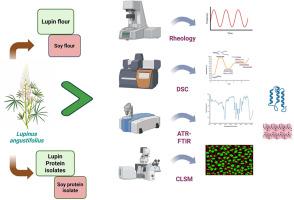以大豆为对照,比较分析澳洲甜豆品种分离蛋白和籽粒粉的热、结构和流变特性
IF 11
1区 农林科学
Q1 CHEMISTRY, APPLIED
引用次数: 0
摘要
本研究以豆粉和分离蛋白为参照,对5个品种的豆粉和分离蛋白的热、结构和流变学特性进行了研究。傅里叶变换红外(FTIR)分析显示,酰胺I区分离的lupin蛋白中β-薄片的含量明显高于α-螺旋,两者共占二级蛋白结构的约50%。在差示扫描量热法(DSC)中,罗苹粉表现出两个明显的峰变性温度(Td),第一个峰变性温度在90 ~ 91℃之间,第二个峰变性温度在103 ~ 105℃之间。同样,对于lupin蛋白分离物,两个Tds分别在84-86°C和96-98°C,分别代表β-凝集素和α-凝集素。与大豆相比,罗苹蛋白的微观结构相互联系较少,具有更紧密和连续的蛋白质网络。与大豆蛋白分离物相比,罗苹蛋白分离物具有较低的复合粘度(k * *)、储存(G′)和损失(G”)模量,以及较高的损失因子(tan δ),因此形成较弱且易变形的凝胶网络。面粉的特征是比蛋白质分离物更依赖于频率,表明较弱的凝胶网络。快速粘度分析仪(RVA)分析结果显示,豆粉的峰值粘度(237.00 ~ 265.00 cP)和最终粘度(3.38 ~ 4.89 cP)均高于豆粉(166.33 cP和1.11 cP),表明非淀粉组分对豆粉糊化性能的影响。由于罗苹蛋白形成的凝胶比大豆弱,因此对其在食品中的功能进行工艺调整是必不可少的。此外,与大豆粉相比,与豆粉相关的高Td显示出更大的热稳定性,这在热处理的高蛋白产品中可能是有益的。本文章由计算机程序翻译,如有差异,请以英文原文为准。

Comparative analysis of thermal, structural and rheological properties of protein isolates and kernel flour from Australian sweet lupin varieties using soy as a reference
This study demonstrates the thermal, structural, and rheological properties of flours and protein isolates of five Lupinus angustifolius L. varieties using soy flour and protein isolate as references. Fourier transform infrared (FTIR) analysis of lupin protein isolates in the amide I region revealed significantly higher β-sheet content than α-helices, together comprising ∼50 % of the secondary protein structures. In differential scanning calorimetry (DSC), lupin flour exhibited two distinct peak denaturation temperatures (Td), first between 90 and 91 °C, second between 103 and 105 °C. Similarly, for lupin protein isolates, the two Tds were at 84–86 °C and 96–98 °C, which represent β-conglutin and α-conglutin, respectively. The microstructure of lupin proteins was less interconnected than soy, which had a more compact and continuous protein network. Lupin protein isolates form a weaker and easily deformed gel network compared to soy protein isolates due to their lower complex viscosity (ŋ∗), storage (G′) and loss (G") moduli, and higher loss factor (tan δ) compared to soy protein isolates. Flours were characterised as more frequency-dependent than protein isolates, indicating weaker gel networks. Rapid viscosity analyser (RVA) profiles revealed that lupin flours exhibited higher peak (237.00–265.00 cP) and final viscosities (3.38–4.89 cP) than soy flour (166.33 cP and 1.11 cP, respectively), indicating the influence of non-starch components on enhanced pasting properties in lupin flours. Since lupin proteins form weaker gels than soy, process modulations are essential to improve their functionality in food products. Moreover, higher Td associated with lupin flour over soy flour demonstrate greater thermal stability, which is potentially beneficial in heat-processed, high-protein products.
求助全文
通过发布文献求助,成功后即可免费获取论文全文。
去求助
来源期刊

Food Hydrocolloids
工程技术-食品科技
CiteScore
19.90
自引率
14.00%
发文量
871
审稿时长
37 days
期刊介绍:
Food Hydrocolloids publishes original and innovative research focused on the characterization, functional properties, and applications of hydrocolloid materials used in food products. These hydrocolloids, defined as polysaccharides and proteins of commercial importance, are added to control aspects such as texture, stability, rheology, and sensory properties. The research's primary emphasis should be on the hydrocolloids themselves, with thorough descriptions of their source, nature, and physicochemical characteristics. Manuscripts are expected to clearly outline specific aims and objectives, include a fundamental discussion of research findings at the molecular level, and address the significance of the results. Studies on hydrocolloids in complex formulations should concentrate on their overall properties and mechanisms of action, while simple formulation development studies may not be considered for publication.
The main areas of interest are:
-Chemical and physicochemical characterisation
Thermal properties including glass transitions and conformational changes-
Rheological properties including viscosity, viscoelastic properties and gelation behaviour-
The influence on organoleptic properties-
Interfacial properties including stabilisation of dispersions, emulsions and foams-
Film forming properties with application to edible films and active packaging-
Encapsulation and controlled release of active compounds-
The influence on health including their role as dietary fibre-
Manipulation of hydrocolloid structure and functionality through chemical, biochemical and physical processes-
New hydrocolloids and hydrocolloid sources of commercial potential.
The Journal also publishes Review articles that provide an overview of the latest developments in topics of specific interest to researchers in this field of activity.
 求助内容:
求助内容: 应助结果提醒方式:
应助结果提醒方式:


